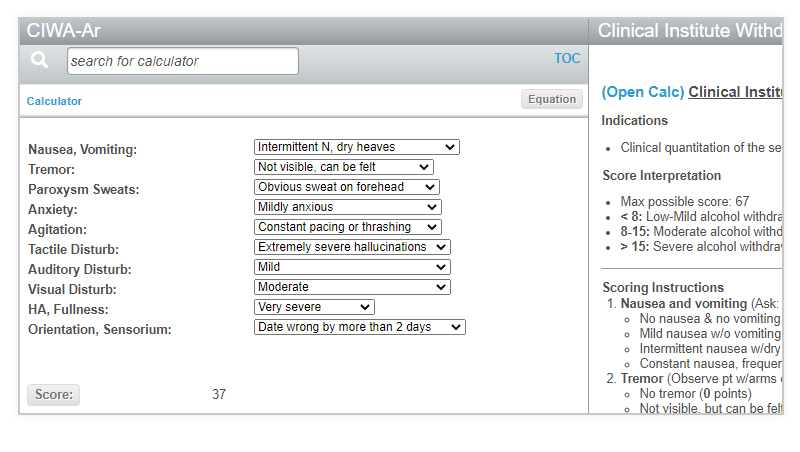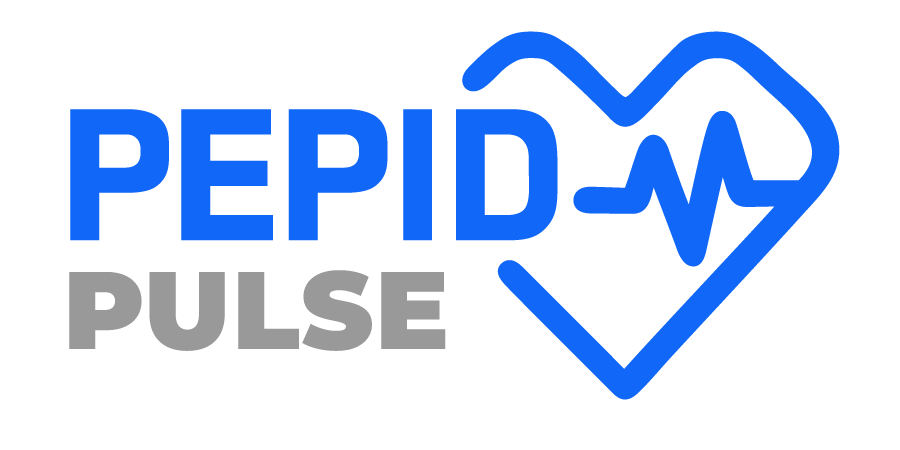The Nurses role in recognizing & responding to Alcohol Withdrawal Syndrome
April is Alcohol Awareness Month. 5.3% of people 12 and older in the U.S. (equaling 14.5 million) have alcohol use disorder and may be at high risk of alcohol withdrawal syndrome during an unexpected hospital visit. Early signs for alcohol withdrawal syndrome like sweating, headache, nausea, and irritability are common among hospitalized patients and can be easily overlooked, however, escalation of alcohol withdrawal syndrome can prove deadly. Nurses should routinely screen for chronic alcohol abuse and consider the possibility that their patients may develop alcohol withdrawal syndrome (AWS) during their hospital stay. Bedside screening & clinical decision support tools can help standardize this process, support early detection and intervention.
Alcohol withdrawal syndrome is a complication of Alcohol Use Disorder (AUD), the diagnostic term used by medical professionals to essentially describe alcoholism. To avoid severe, life-threatening AWS, it is paramount for nurses to understand the prevalence of alcohol abuse in the U.S.A., consider the likelihood of their patients will have alcohol withdrawal syndrome, and respond to AWS severity during hospitalization. This article will help nursing students and novel nurses use nationally recognized screening tools to recognize alcohol use disorder as well as screening & decision support tools for assessing and responding to alcohol withdrawal symptoms in patients.
Prevalence of Alcohol Withdrawal Syndrome in the Acute-Care Hospital Setting
The prevalence of alcohol consumption in the United States is high. Chronic alcohol consumption according to the 2019 National Survey on Drug Use and Health (NSDUH) sits at 5.3 percent of people 12 and older which is about 14.5 million. Another study claims 15-25% of patients entering the acute-care hospital setting have some form of alcohol dependence or high-risk drinking behavior. 10% of those will demonstrate signs of alcohol withdrawal syndrome during admission. Nurses must consider the possibility that their patients may show signs of alcohol withdrawal syndrome and manage those symptoms accordingly.
Effects of Chronic Alcohol Consumption
Alcohol withdrawal symptoms are caused by the abrupt decrease of alcohol concentration and unmasking of compensatory excitatory neurotransmitters hyperactivity. In a nutshell, chronic drinking causes what is referred to as “kindling,” which is a cyclical chemical imbalance in the brain from imbibing and withdrawing that intensifies withdrawal symptoms with each subsequent withdrawal. This repeated cycle of drinking and withdrawing may lead to increased relapse, brain damage, and a higher likelihood of future life-threatening withdrawal.
The more frequent the cycles of drinking and abstinence, the higher a person’s alcohol tolerance gets and the sooner the withdrawal symptoms appear. Alcohol depresses the central nervous system (CNS), and many other mechanisms in the body. Once the drinking stops, the body responds with neurotransmitter hyperactivity to compensate, this causes the symptoms of Alcohol Withdrawal Syndrome.
Alcohol Withdrawal Syndrome Signs
Withdrawal occurs after long periods of sustained high blood-alcohol levels. Just hours after the last drink, patients may experience sweating, headache, hypertension, tachycardia, fine tremor, nausea/vomiting, anxiety, emotional lability, insomnia, and irritability. Many symptoms of AWS can be easily overlooked because they are common among hospitalized patients; however, without proper intervention, these symptoms may escalate to severe or even life-threatening.
Seizures may occur within 2-48 hours of the patient’s last drink. This is often seen in patients with a long history of heavy alcohol use. 3% of alcoholics have seizures and 3% of that 3% develop status epilepticus. Patients may see hallucinations within 12-48 hours of abstinence that resolve within 24-48 hours.
3-5% of patients experience delirium tremens, a serious medical emergency with a mortality rate of up to 5%. It’s important to note that the duration of abstinence required to produce withdrawal and the serum alcohol level at which withdrawal symptoms occur vary greatly between patients.
Nurses must assess each patient’s alcohol intake upon admission to better prepare for the possibility of Alcohol Withdrawal Syndrome, bedside quick refs can help.
Use the Alcohol Use Disorder Identification Test(AUDIT) to screen patients for unhealthy alcohol use. When using the AUDIT, focus on recent alcohol use. First, inform the patient of the questionnaire, then encourage patients to answer the questions even if they are underaged or not socially sanctioned to drink (i.e. observant Muslims). Use a local example of what an “alcoholic beverage” means, such as 1 bottle of beer, 1 glass of wine, or 1 shot of vodka.
Pro Tip: If the patient responds to the first question as no, they have not had any drinks during the past year or scores a 0 on questions 2 and 3, you can skip right ahead to questions 9-10. More screening tools can be found on PEPID’s Alcohol Abuse: Screening and Diagnosis Monograph. If these screenings point to excessive alcohol consumption, hazardous and harmful alcohol use, and/or alcohol dependence, nurses should consider the likelihood that this patient may suffer AWS during their hospital stay.
Early recognition and consistent intervention is key
If screening indicates there is potential for AWS, it’s time to break out the Clinical Institute Withdrawal Assessment for Alcohol Revised Scale (CIWA-Ar). Use the CIWA-Ar to assess the presence of 10 AWS symptoms: nausea and vomiting, tremor, paroxysmal sweats, anxiety, agitation, tactile disturbances, auditory disturbances, visual disturbances, headache (or fullness in the head), and orientation and clouding of sensorium. In the PEPID’s Professional Nursing Suite or RN Student Clinical Companion, the CIWA-Ar equation monograph includes exact questions you can ask the patient to assess each symptom. When you open the CIWA-Ar calculator marked (Open Calc), you can quickly submit each answer in real-time at the bedside, and quickly calculate the severity score. A score of less than 8 means the patient has mild withdrawal, scores from 8-15 are Moderate Withdrawal, and any score greater than 15 is Severe Withdrawal.

Guided treatment bedside decision support
Now that AWS symptom severity has been determined, a glance at two clinical monographs can give nursing students or first-year nurses the confidence they need to support their nursing care decision-making. Nursing students can bookmark the Alcohol Abuse: Withdrawal monograph to see important treatment and nursing considerations before moving forward with a care plan. The Ethanol Withdrawal (Alcohol Withdrawal by Severity) monograph details pathophysiology, diagnostics, treatment and disposition for each stage of withdrawal that correlates with scores from the Clinical Institute Withdrawal Assessment of Alcohol Scale.
The goal of AWS management is to alleviate symptoms and maintain cardiovascular and respiratory function until the patient successfully withdrawals from alcohol. Continued monitoring of severity changes is essential until that point. Finally, the nurse, discharge planner, and primary care provider should work together to educate the patient on alcohol abuse, and alcohol withdrawal syndrome to mitigate hospital readmission and healthy life changes. This may include a referral to outpatient counseling, rehabilitation, or other community resources.
Bedside Quick References from Professional Nursing Suite
Sources
Alcohol facts and statistics. (n.d.). Retrieved April 08, 2021, from https://www.niaaa.nih.gov/publications/brochures-and-fact-sheets/alcohol-facts-and-statistics
Anwar, M., MD, & Pomerleau, A., MD. (2019, March). Ethanol Withdrawal. Retrieved April 08, 2021, PEPID Professional Nursing Suite
Czarnik, S. (2020, January). Alcohol withdrawal in hospitalized patients. Retrieved April 08, 2021, PEPID Professional Nursing Suite
Hernandez, J., DO. (2015, January). Alcohol Abuse: Screening and Diagnosis. Retrieved April 08, 2021, PEPID Professional Nursing Suite
NIH study shows steep increase in rate of alcohol-related ER visits. (n.d.). Retrieved April 08, 2021, from https://www.niaaa.nih.gov/news-events/news-releases/nih-study-shows-steep-increase-rate-alcohol-related-er-visits
Wallace, K., & Ballarin, D., MD. (2015, December). Alcohol Abuse: Withdrawal. Retrieved April 08, 2021, PEPID Professional Nursing Suite


Trackbacks/Pingbacks